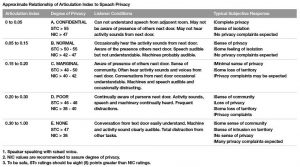by Gary Brown

For multi-unit living spaces, hospitals, and offices, privacy has become a significant issue (as a side issue, the issuing of the American National Standards Institute [ANSI] S12.60, Acoustical Performance Criteria, Design Requirements and Guidelines for Schools, has made privacy between classrooms an issue of concern). Architects and designers only have sound transmission class (STC) ratings to guide them when selecting acoustical insulation for walls. Very little distinction is made between STC, apparent sound transmission class (ASTC), and noise isolation class (NIC) (STC is a laboratory test to measure the transmission of sounds through a sample of a basic wall construction with no electrical boxes or other ‘violations’ of the structure. Field sound transmission class (FSTC) is an in-situ test identical—in most respects—to STC except it is assessing a wall in the real world. Both STC and FSTC are reduced to per square foot and corrected for acoustical absorption in the receiving [listener’s] room. NIC is similar to FSTC except no correction is made for wall area or absorption in the receiving room. NIC is a ‘what you hear is what you get,’ to paraphrase a famous comedian. All of these tests are detailed in ASTM procedures). Even with the best construction practices, ASTC and NIC can be significantly lower than STC, almost five to 10 points 9 (it is worth noting theoretically, if FTC is 3 dB [or greater] less than STC, more acoustical power is leaking around the wall [flanking] than transmitted through the basic wall itself. With poor construction, this can be more significant.
When individuals reside in condos and apartments, they do not want to hear conversations happening in the next unit. This is accomplished by constructing adequate walls to sufficiently block the sound. However, what is considered ‘adequate,’ and how does this relate to ratings like STC and NIC? This is a complex issue. There is a relationship between wall ratings and acoustical privacy. There is a tried-and-true method of pairing the articulation index (AI)—the ability to understand spoken sentences—with the subjective conditions for privacy.
Speech privacy

Images courtesy McClure Engineering
AI was developed to quantify privacy, which is a subjective issue (the entire procedure as set forth in ASTM E90, Standard Method for Laboratory measurement of Airborne Sound Transmission Loss of Building Partitions, neglects sound below 125 Hz, which is often of primary concern). The index is based on the ability to not necessarily hear sound from the adjoining room, but to not understand spoken words or sentences. The computation of AI is a number-crunching exercise that considers the levels and frequency spectrums of both the speaker’s voice (the source) and the background sound surrounding the listener.
The calculations include weighting the sound reaching the listener by relative importance in each of the sixteen 1/3 octave bands used in the analysis. The relative weightings have been determined by ‘jury tests’ in which many people have listened and rated sample sounds. ‘Test subjects’ in laboratory-based annoyance studies are generally screened for audiometric zero tolerance levels. Audiograms are also routinely administered after completion of testing as part of the informed-consent process required in federally funded studies (for more information, read the Handbook of Acoustical Measurement and Noise Control [third edition] by Cyril M Harris).
Figure 1 rates the nominal correlation of AI with the degree of privacy, as described in the third column of the table. The table is actually based on face-to-face conversation, but also holds good for the application discussed here. The underlined sections in Figure 1 are applicable to room-to-room privacy.
Sound transmission through walls
The perception of sound transmitted from one room to an adjacent space depends on four factors:
- intensity and frequency of sound in the source room;
- attenuation of the common wall (transmission loss);
- area of the wall;
- acoustical absorption in the receiving room; and
- the locations in the room are greater than 1 m (3 ft) from the common wall.
STC and ASTC are intended to measure only the transmission loss (TL) of the common wall (refer to ASTM E90, Standard Method for Laboratory measurement of Airborne Sound Transmission Loss of Building Partitions). STC measurers TL in a laboratory setting where all parameters are under the control of the testing agency (consult ANSI S3.5, Methods for the Calculation of the American Index). ASTC measures TL in a field setting where parameters of the common wall depend on design considerations and workmanship even though the primary structure of the wall is the same in both cases. In most instances, the wall design considers the main components incorporated in the test wall, such as studs (metal and wood), insulation, drywall materials, and types of wall fasteners.




